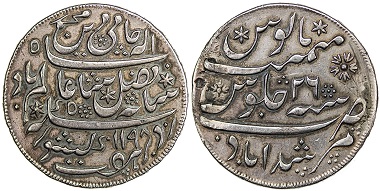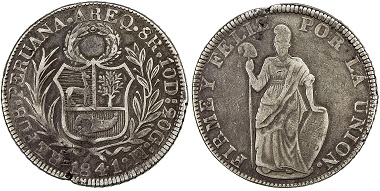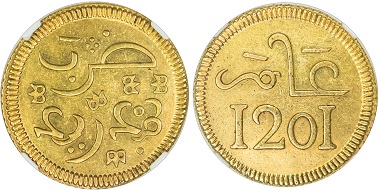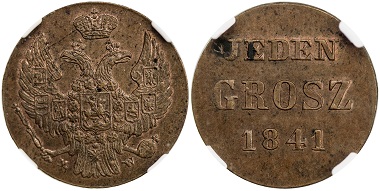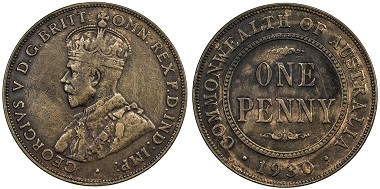18-05-2016 – 20-05-2016
Auction 25
Stephen Album Rare Coins Auction 25
The next auction by Stephen Album Rare Coins will be held from May 19-21, 2016. The auction will consist of 2,680 lots, and covers the areas of Ancient, Islamic, Chinese, Indian, and World Coins, in addition to Numismatic Literature.
Lot 1302: Bengal Presidency, “Murshidabad”, AH 1198 year 26 (1784), double rupee pattern. Stevens-3.1, KMPn9. VF to EF, RRRR. Estimate $6,000-8,000.
A highlight of the sale is Part III of the Dr. Paul Stevens Collection of Indian Coins. The collection features an impressive and historically important representation of coins of the Bengal Presidency. Included are items of extreme rarity, such as a double rupee pattern; many rare or unique mohurs, nazarana mohurs and pattern mohurs; trials and patterns of “Murshidabad” rupees (struck at Calcutta); a pattern rupee of Farrukhabad; numerous Soho mint patterns; Benares mint patterns, as well as an assortment of mint state mohurs, rupees and coppers.
Also offered in the Dr. Paul Stevens Collection is an assortment of coins of the Mughal Empire, and coins from the Princely States of Aurangabad, Dholpur, Dungarpur, Elichpur, Farrukhabad, Gadwal, Gwalior, Hyderabad, Indore, Kalaywn, Narayanpett and Wanparti. The collection of coins from Gwalior is of utmost importance, containing seldom encountered rarities. Rounding out the offerings from this collection are items from Danish, French, Dutch and Portuguese India.
Lot 2510: Peru, 1841-AREQ, 8 reales. KM-142.11, El-148, Cr-132-2a, Flatt (1996) Figure 28. Edge defect at 11:30, but attractive nonetheless for this exceedingly rare issue, VF, RRR. Estimate $10,000-12,000.
The firm continues to build its offerings of World Coins. In particular there are many nice coins from Mexico and other Latin American countries in this sale.
Some highlights from Auction 25 are as follows:
Lot 1893: Morocco, Muhammad III, 10 mitqals. NGC graded AU details, RRR. Estimate $10,000-15,000.
This piece is among the first machine struck coins of Morocco. Authorization to produce this issue was granted January 13, 1787, under Sultan Muhammad III. Although listed in some references as a pattern, this issue was clearly intended for circulation. The production started September 22, 1787. A total of 10,000 pieces were struck from bullion stored in the city of Tangier. Although well executed, for multiple reasons this issue was destined for failure. The first reason was logistical, as the shipment arrived late, after the death of Muhammad III. The new Sultan Muhammad al-Yazid would not want to place these coins of the previous ruler into circulation. The coins also bear the name of the Madrid Mint in Arabic. This would compromise their acceptance among the Moroccan people as there was tension between the two countries. Nearly the entire mintage was recalled and melted down, and as few as 10 specimens are known to have survived.
Lot: 2204: Poland, Nicholas I, jeden grosz pattern. NGC graded MS61 BR, RRRR. Estimate $20,000-25,000.
Nicholas I, 1825-1855, AE jeden grosz pattern, [Warsaw], 1841, KM-Pn218, BIT-1244, Crowned small Russian two-headed eagle with Polish shield / denomination and date in 3 lines, traces of original red luster.
Lot 2580: Australia, George V, penny. NGC graded F15 BR, RR. Estimate $7,000-9,000.
The 1930 penny is probably the most famous of all the Australian Commonwealth coins. Its existence was not known for some time after the coin was released into circulation. According to an article entitled “Notes on Australian Pre-decimal Coinage” by Bill Mullett, published in the 1996 Journal of the Australian Numismatic Society, “The now famous 1930 penny was the result of experimental work undertaken to produce better pennies for the 1930s.” No pennies were ordered by the Treasury for 1930. The 1931 order did not specify a date to appear on the coins and so the good coins from the 1930 experimental work were available for distribution with the 1931 mint issue. It is not known how many 1930 pennies were struck. Estimates vary from around 2,000 to 10,000 with about 3,000 being the most commonly quoted figure. Only about 1,500 coins are being traded in the marketplace.
Lot viewing is available at the firm’s offices, May 16 to 18, 10:00 to 17:00, by appointment.
You may view all lots online here.





